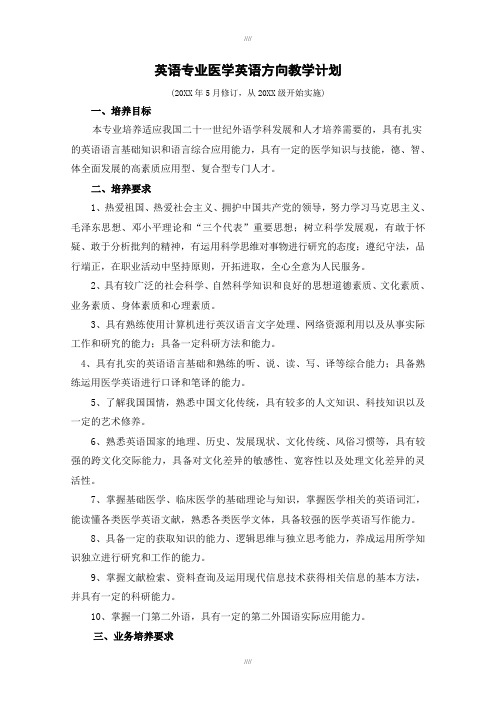医学英语教学目的 英文版
英语医学教学设计

汇报人:XX
Part One
Part Two
Part Three
Part Four
Part Five
Part Six
评估方式:通过测试、作业、课堂表现等方源自评估学生的学习效果,及时调整教学策略。
教学方法:采用情景教学、案例分析、角色扮演等教学方法,激发学生的学习兴趣和参与度。
目标:帮助学生掌握医学英语词汇、语法和表达方式,提高医学英语听说读写能力,为将来的医学学习和实践打下坚实基础。
教学目标:提高医学生英语水平,增强医学知识理解能力
教学方式:讲授、讨论、案例分析、实践操作等
教学评价:定期测试、作业批改、课堂表现等
教学内容:医学术语、病例分析、医学文献阅读等
语法学关注语言的结构规则和句法结构
语义学关注语言的意义和词汇关系
语用学关注语言的使用和语境因素
语言学理论是英语医学教学设计的基础
教辅材料:准备相关的练习题、案例分析、视频资料等辅助教学
添加标题
教材改编:根据教学需要进行教材内容的改编和补充
添加标题
教材更新:定期更新教材和教辅材料,以适应医学发展的新趋势
添加标题
信息技术在英语医学教学中的应用
多媒体资源在英语医学教学中的作用
常见的信息技术与多媒体资源类型
如何选择合适的信息技术与多媒体资源进行教学设计
制定评估标准:明确评估目标和内容,制定科学合理的评估标准
分析评估结果:对评估结果进行深入分析,找出存在的问题和不足
反馈与改进:根据评估结果和学生反馈,对教学设计进行改进和完善,提高教学效果
实施评估:按照评估标准进行教学效果评估,收集学生反馈信息
教材选择:根据教学目标和学生需求选择合适的教材
医学专业英语教学内容

cardiovascular diseases;脑垂体的功能the function of pituitary;泌尿道urinary tract;分子molecule;动脉artery;内分泌学endocrinology;呼吸困难dyspnea;唾液saliva;组织学histology;血液循环blood circulation;血液学hematology;生理学physiology;解剖学anatomy;女性生殖系统femal reproductive system; 神经细胞nerve cell;免疫学immunology;消化不良dyspepsia;随意肌voluntary muscle;胚胎学embryology;心理学psychology;细胞学cytology;原生质protoplasm;细胞膜cell membrane;细胞核nucleus;细胞质(浆)cytoplasm;脱氧核糖核酸deoxyribonucleic acid;能半渗透的semipermeable;分子生物学molecular biology;碳水化合物carbohydrate;有区别性的differentially;使…完整intact;根据according to;遗传特性hereditary trait;渗滤diffusion;转换transaction;蓝图blueprint;染色体chromosome;色素pigment;排出废液excrete waste fluid;散开disperse;脉冲信号impulse;核糖核酸ribonucleic acid;损害正常功能impair the normal function; 污染环境pollute environment;功能失调malfunction;致病因子causative agents;易受侵害的人群vulnerable groups;局部化的感染localized infection;花柳病venereal disease;抗原与抗体antigen&antibody;肌电图electromyogram;多发性硬化multiple sclerosis;心电图electrocardiograph;疾病的后遗症sequelea of disease;光纤技术fiber optic technology;造血系统hematopoietic system;致命的疾病fatal disease;体液body fluid; 无副作用的治疗hazard-free treatment;无侵犯的实验检查non-invasive laboratory test; 核磁共振nuclear magnetic resonance;葡萄糖耐糖实验the glucose-tolerance test;乐观的预后optimistic prognosis;超声波检测法ultrasonography;病史medical history;随访活动follow-up visit;营养不良nutritional deficiency;使细节显著highlight detail;脑电图electroencephalogram;缺血的组织blood-starved tissue;肌纤维muscle fiber;随意肌voluntary muscle;消化道alimentary canal;肌腹fleshy belly of muscle;横纹肌striated muscle;肌肉痉挛cramps of muscle;肌肉收缩muscle contraction;肌肉附着点attachment of the muscle;肌肉放松relaxation of muscle;动脉出血arterial hemorrhage;止端insertion;起端origion;供血blood supply; 屈肌flexor;蛋白分子protein molecule;纤维结缔组织fibrous connective tissue;伸肌extensor;意志力willpower;横切面transverse section;起搏器pacemaker;肌萎缩muscle atrophy;重症肌无力myasthenia gravis;弥散性局部缺血diffuse ischemia;常染色体隐性autosomal recessive;全身性感染systemic infection;受累的肌肉muscle involved;显著相关性significant correlation;神经末梢nerve terminal;自体免疫反应autoimmune reaction;神经支配innervation;肌营养不良muscular dystrophy;慢性营养不良chronic mulnutrition;先天性肌病congenital myopathy;预期寿命life expectancy;免疫紊乱immunologic derangemant;发病高峰年龄the peak age of onset;胸腺肿瘤thymoma;呼吸肌受累the involvement of respiratory muscle; 感染性肌炎inflammatory myositic;去神经支配denervation;矿物质吸收mineral absorption;机械应力mechanical stress;骨基质有机部分the organic parts of bone matrix; 青春期早熟premature puberty;蛋白溶解酶protein-digesting enzyme;破骨细胞osteoclast;松质骨spongy bone;骨折fracture;不规则骨irregular bone;骨骼系统skeletal system;维生素吸收vitamin absorption;骨钙丧失the loss of calcium from bone;生长激素growth hormone;骺软骨epiphyseal cartilage;镁缺乏magnesium deficiency;成骨细胞osteoblast;密质骨compact bone;骨髓腔marrow cavity;红骨髓red marrow;软骨内骨化endochondral ossification;矫形学orthopedics;闭合性骨折closed fracture;骨代谢疾病metabolic bone disease;雌激素替代疗法estrogen replacement therapy; 肾上腺皮质adrenal cortex;佝偻病rickets;骨肉瘤osteosarcoma;软骨肉瘤chondrosarcoma;止痛relieve pain;类风湿关节炎rheumatoid arthritis;骨髓炎osteomyelitis;开放性骨折open fracture;骨质疏松症osteoporosis;营养缺乏nutritional deficiency;骨软化症osteomalocia;听力丧失hearing lose;恶性肿瘤malignant tumor;关节炎arthritis;抗炎剂anti-inflammatory drugs;痛风gout;牙周组织periodontium;唾液腺salivary glands;口腔oral cavity;升结肠ascending colon;贲门括约肌cardiac sphincter;乳化作用emulsification;消化道alimentary tract;脾弯曲splenic flexure;锥形的突起cone-shaped papillae;似袋状的器官pouch-like organ;会厌epiglottis;十二指肠duodenum;乙状结肠sigmoid colon;幽门括约肌pyloric sphincter;舌下腺sublingual gland;蠕动peristalsis;下颌下腺submandibular gland;解毒作用detoxification;回盲瓣ileocecal valve;胰岛素insulin;穿孔perforation;溃疡性结肠炎ulcerative colitis;纤维变性fibrosis;阑尾炎appendicitis;胃十二指肠吻合术gastroduodenostomy;直肠镜proctoscope;裂孔疝hiatal hernia;造影剂contrast medium; 代偿失调decompensation;胆石病choletithiasis;内窥镜检查endoscopy;胆囊切除术cholecystectomy;憩室炎diverticulitis;麻痹性肠梗阻paralytic ileus;胆绞痛biliary colic;一个系列的 a spectrum of;副鼻窦paranasal sinus;口咽oropharynx;脊椎动物verterbrate animal;肺泡alveolus;二氧化碳carbon dioxide;肺换气不足hypoventilation;横膈膜神经phrenic nerve;双重折叠的double folded;威慑物deterrent;润滑液lubricating fluid;滞痰stagnant sputum;食管esophagus;纵隔mediastinum;哺乳动物mammal;碱中毒alkalosis;迷宫labyrinth;污染物质pollutant;脑干brainstem;上皮,上皮细胞epithelium;刺激物irritant;利尿剂duretics;大叶性肺炎lobar pneumonia;疾病的鉴别differentiation of disease;破坏性的损坏destructive damage;痰性咳嗽productive cough;共存coexist;医学文献medical literatures;咯血nemoptysis;渗出物,渗出液exudate;痰液phlegm;气促,气短breathless;无症状的asymptomatic;吸烟者晨咳morning cigarette cough;肺弹性回缩elastic recoil;反复发作recurrent episodes;有毒刺激物质nonxious agents;连续三年successive 3 years;交叉重复crossover;互相排除的mutually exclusive;小气道闭塞obliteration of small airway; 主动脉弓aortic arch;胸主动脉thoracic aorta;舒张压diastolic pressure;腹主动脉abdominal aorta;收缩压systolic pressure;脊柱vertebral colum;毫米汞柱mmHg;半月形的semilunar;最里层的innermost;升主动脉ascending aorta;二尖瓣bicuspid valve;体循环systemic circuit;上腔静脉superior vena cava下腔静脉inferior vena cava;心肌myocardium;心内膜endocadium;细分;分支subdivision;心外膜epicardium;小动脉arteriole;心包pericardium;全血细胞减少pancytopenia;网织红细胞reticulocyte;自身免疫的autoimmune;危及生命的life-threatening;凝结cougulation;血小板减少thrombocytopenia;免疫缺陷immunodeficiency;功能紊乱dysfunction;活疫苗live vaccine;移植物对宿主的反应graft-versus-host reaction;血友病hemophilia;素质diathesis;巨成红细胞megaloblast;自发病,特发病idiopathic;弥散性血管内凝血disseminated intravascular coagulation;instrinsic;appendic/o>appendix阑尾炎2bil/i/rubin bil/i>bile胆红素3chondr/o/sarc/oma chrondr/o >cartilage ; sarc/o >flesh 软骨肉瘤4chol/sterol chol/e > bile, gall胆固醇5bucc/al bucc/o > bucca口腔的;颊的6crani/al crani/o > skull颅的,颅侧的7colon/o/scope colon/o > colon结肠镜8sigmoid/o/scope sigmoid/o > sigmoid colon乙状结肠镜9inter/cost/al cost/o > rib肋间的10dent/in dent/o > teeth牙质11epi/gastr/ic gastr/o > stomach胃上部的,腹上部的12enter/itis enter/o > small intestine肠炎13arthr/itis arthr/i > joint关节炎14bronch/o/genic bronch/o > bronchus支气管原的15cec/um cec/o > cecum盲肠16sub/lingu/al lingu/o > tongue舌下的17gingiv/itis gingiv/o > gum牙龈炎18nas/o/gastr/ic gas/o > nose gastr/o > stomach鼻饲的19hypo/pharyng/eal pharyng/o > pharynx下咽的20diverticul/osis diverticul/o > diverticulum憩室病21ile/o/stomy ile/o > ileum回肠造口术22chol/e/cyst/ectomy chol/e > bile; cyst/o > sac胆囊切除术23abdomin/al abdomin/o > abdomen腹部的24pneumon/ia pneumon/o > lung肺炎25thorac/ic thorac/o > pleural cavity ,chestcavity 胸腔的26duoden/um deoden/o > duodenum十二指肠27laryng/o/pharynx larygn/o > larynx pharyng/o >pharynx 咽喉28vertebr/ate vertebr/o > back bone脊椎动物29oste/o/myel/itis oste/o > bone;myel/o > bonemarrow 骨髓炎30pancreat/ic pancreat/o>pancreas胰腺炎31angi/o/plasty angio>vessels血管成形术32extra/o/cular extra>outside细胞外的33tendon/ous ten>tendon肌腱的34mamm/o/graphy mamm>breast乳房X线检查术35electr/o/my/o/gram electr>electricity,my>muscle肌电图36erythr/o/cyte eryth>red红细胞37hem/o/globin globin>protein血红蛋白38prot/o/plasm prot>first原生质39urin/ary ary>pertaining to泌尿道的40neur/o/pathy neur>nerve神经疾病41lymph/atic lymph>lymph淋巴的42my/o/fiber my>muscle肌纤维43pelv/ic pelv>pelvic bone盆骨44hepat/itis itis>inflammation肝炎45fibr/ous fibr>fiber纤维的46embry/o/logy embry>embryo胚胎学47leuk/emia emia>blood condition 白血病48electr/o/cardi/o/graph graph>instrument of recording 心电图仪49dermat/o/my/o/sitis dermat>skin 皮肤炎50thym/ectomy ectomy>surgical exasion or removal of 胸腺切除术51cyt/o/plasm cyt>cell 细胞浆52isch/emia isch> to hold back 局部缺血53steth/o/scope stech> the chest 听诊器54pulmon/ary pulmon>lung 肺的55sarc/o/plasm plasm>formation growth or substance of formation 肌浆56chrom/o/some some>body 染色体57vascul/ar vascul>blood vessel5岁小男孩。
《中医专业英语(一)》教学大纲

《中医专业英语(一)》教学大纲课程名称:中医专业英语(一)开课(二级)学院:外语教学中心课程性质:选修课学分:4分学时:56学时前期课程:中医英语基础授课对象:中医药类各专业(本科)考核方式:考试课程简介:本课程是以中医学专业知识和普通英语为基础的专业英语课。
课程主要内容包括中医基础理论英语表达、中西医文化差异、中医经典术语及常用短语翻译、中医门诊英语口语训练、中医药学科技讲座英语听力训练等内容。
本课程的教学目的是使学生了解和掌握中医英语翻译的基本方法与技巧,逐步具备运用专业英语从事医疗、科研及国际交流的能力。
This course is a specialized one based on common English and traditional Chinese medicine (TCM). Its main contents include the English expression of basic theories of TCM, the cultural differences between Chinese and Western medicine, the translation of classical terms and commonly used phrases in TCM, spoken English training for outpatient service, listening practice of TCM sci-tech lectures in English and so on. The purpose of the course is to train students to understand and master the basic methods and techniques of TCM English translation and acquire the professional English skills for taking part in the clinic and research work as well as international exchange.大纲内容一、前言【课程目的】本课程是以中医学专业知识和普通英语为基础的专业英语课,旨在培养和提高学生中医专业英语水平,掌握中医翻译的方法与技巧,逐步具备中医专业英语翻译能力,为进一步从事对外医疗活动以及国际学术交流奠定坚实的基础。
英语专业医学英语方向教学计划(范文)(加精)

英语专业医学英语方向教学计划(20XX年5月修订,从20XX级开始实施)一、培养目标本专业培养适应我国二十一世纪外语学科发展和人才培养需要的,具有扎实的英语语言基础知识和语言综合应用能力,具有一定的医学知识与技能,德、智、体全面发展的高素质应用型、复合型专门人才。
二、培养要求1、热爱祖国、热爱社会主义、拥护中国共产党的领导,努力学习马克思主义、毛泽东思想、邓小平理论和“三个代表”重要思想;树立科学发展观,有敢于怀疑、敢于分析批判的精神,有运用科学思维对事物进行研究的态度;遵纪守法,品行端正,在职业活动中坚持原则,开拓进取,全心全意为人民服务。
2、具有较广泛的社会科学、自然科学知识和良好的思想道德素质、文化素质、业务素质、身体素质和心理素质。
3、具有熟练使用计算机进行英汉语言文字处理、网络资源利用以及从事实际工作和研究的能力;具备一定科研方法和能力。
4、具有扎实的英语语言基础和熟练的听、说、读、写、译等综合能力;具备熟练运用医学英语进行口译和笔译的能力。
5、了解我国国情,熟悉中国文化传统,具有较多的人文知识、科技知识以及一定的艺术修养。
6、熟悉英语国家的地理、历史、发展现状、文化传统、风俗习惯等,具有较强的跨文化交际能力,具备对文化差异的敏感性、宽容性以及处理文化差异的灵活性。
7、掌握基础医学、临床医学的基础理论与知识,掌握医学相关的英语词汇,能读懂各类医学英语文献,熟悉各类医学文体,具备较强的医学英语写作能力。
8、具备一定的获取知识的能力、逻辑思维与独立思考能力,养成运用所学知识独立进行研究和工作的能力。
9、掌握文献检索、资料查询及运用现代信息技术获得相关信息的基本方法,并具有一定的科研能力。
10、掌握一门第二外语,具有一定的第二外国语实际应用能力。
三、业务培养要求(一)专业知识要求1、了解我国国情,熟悉中国文化传统,具有较多的人文知识、科技知识以及一定的艺术修养。
2、熟悉英语国家的地理、历史、发展现状、文化传统、风俗习惯等,具备对文化差异的敏感性、宽容性以及处理文化差异的灵活性。
医学英语课程教学大纲(详细)

《医学英语》课程教学大纲课程类别: 专业分化课适用对象: 涉外护理专业分化方向的学生总学时:56 讲授学时:56 课内实践学时:0独立实践学时:0一、课程的性质、任务与基本要求(一)性质与任务!本课程为涉外护理专业的专业英语考试课,是在学习了大学英语后所开设的课程。
本课程的任务是帮助涉外护理专业方向的学生在学习护理专业英语词汇,为有出国就业或国内涉外医院工作意向的学生学习和运用护理专业英语打下良好的基础,以达到培养应用型人才的教学目的。
(二)基本要求本大钢对学习该课程的学生提出以下要求:1.语音:学生应能应用国际音标准确拼读新的医学单词,2.词汇:3000~4500以上的词汇,并具备一些相关的医学、护理词汇。
3.语法:掌握所有基础语法知识,能够正确理解课文和试题。
二、主要教学内容及教学要求Unit 1 Nursing of the Patients with Blood-System Diseases—主要教学内容血液系统疾病患者的护理(Part1 & Part3)教学要求1、掌握:血液系统常见病,如缺铁性贫血和恶性贫血等的临床表现、治疗、护理及常用药物。
2、熟悉:镰状细胞性贫血和血友病。
Unit 2 Nursing of the Patients with Respiratory-System Diseases主要教学内容呼吸系统疾病患者的护理(Part1 & Part3):教学要求1、掌握:呼吸系统常见病,如COPD、急性哮喘和肺结核等的临床表现、治疗、护理;气管切开、胸腔闭式引流的护理。
2、熟悉:气管异物的观察和急救处理。
Unit 3 Nursing of the Patients with digestive-System Diseases主要教学内容消化系统疾病患者的护理(Part1 & Part3)教学要求1、掌握:消化系统常见病,如胆囊炎、肝硬化、消化道溃疡等的临床表现、检查、治疗和护理;三腔两囊管的护理。
医学英语视听说1教师版

医学英语视听说1教师版Medical English: Listening and Speaking 1 (Teacher's Edition)IntroductionIn today's globalized world, the importance of mastering English in the field of medicine cannot be overstated. Medical professionals from around the world need to communicate effectively in English to provide quality healthcare and collaborate with colleagues internationally. This article presents an overview of the "Medical English: Listening and Speaking 1" textbook for teachers, guiding them on how to effectively teach the course and help students develop their English language skills in the medical context.Course ObjectivesThe primary objective of "Medical English: Listening and Speaking 1" is to enhance students' proficiency in English by focusing on improving their listening and speaking skills. The course aims to:1. Improve students' listening skills to enable them to understand medical lectures, patient histories, and medical discussions.2. Enhance students' speaking skills to enable them to communicate effectively with patients, colleagues, and healthcare professionals in various medical settings.3. Expand students' medical vocabulary and their ability to use specialized medical terms accurately.4. Familiarize students with common medical scenarios and develop their ability to respond appropriately in different clinical situations.Course Structure"Medical English: Listening and Speaking 1" is divided into ten units, each covering different medical topics. The course is designed to progressively increase the level of difficulty, allowing students to build upon their knowledge and skills throughout the semester. Each unit consists of the following components:1. Listening Exercises: This section includes authentic medical audio recordings, such as patient interviews, doctor-patient dialogues, and medical lectures. Students are exposed to a range of accents and medical terminology, helping them improve their listening comprehension skills.2. Speaking Practice: In this section, students engage in conversation activities to practice using medical vocabulary and structures. They are encouraged to participate actively, ask questions, and express their opinions on various medical topics. The teacher plays a crucial role in facilitating discussions and providing feedback.3. Vocabulary Expansion: This component focuses on key medical vocabulary and terminology. Students learn new words, their definitions, and how to use them accurately in medical contexts. The teacher can employ various techniques, such as flashcards, matching exercises, and role-playing, to reinforce vocabulary acquisition.4. Role-Play: Role-plays simulate real-life medical scenarios, allowing students to practice their speaking skills in a practical context. Students takeon different roles, such as doctors, nurses, or patients, and interact using appropriate medical language.5. Pronunciation Drills: Pronunciation exercises help students improve their pronunciation and intonation by practicing medical terms, phrases, and sentences. The teacher guides students in correct pronunciation and provides individualized feedback.6. Listening Strategies: This section equips students with essential listening strategies, such as identifying main ideas, understanding context, and recognizing specific details. Students learn how to effectively comprehend medical audio materials independently.7. Guided Discussions: Guided discussions promote critical thinking and develop students' ability to express their opinions on medical topics. The teacher facilitates discussions, encourages students to provide justifications for their viewpoints, and fosters a supportive learning environment.8. Review and Assessment: Regular review and assessment tasks allow students to consolidate their learning and evaluate their progress. The teacher administers quizzes, tests, and assignments to assess students' understanding and provide constructive feedback for improvement.Conclusion"Medical English: Listening and Speaking 1" equips students with the necessary language skills to effectively communicate in English within the medical field. Through a comprehensive curriculum, including listening exercises, speaking practice, vocabulary expansion, role-plays, pronunciation drills, and guided discussions, students develop theconfidence and proficiency required to succeed in their medical careers. By following the provided guidelines, teachers can facilitate an engaging and interactive classroom environment, fostering continuous learning and growth in medical English proficiency.。
医学英语教学模式研究

已。 虽然很多学校多媒体 已投入使用 , 但 由于缺乏合适的音像 资料 。 仍然没有充分发挥其重要性。 即 使 有 一些 医学 英 语 音 像 资 料 已 问世 , 但 由 于专 业 性 太 强 , 只适合少 部分学生 , 对 于 大 部 分 学 生 。尤 其 是 英 语 水 平 较差 的学 生 ,还是 没有 合适 的 资 料 。因此 , 学 生参 与 的积 极 性 不 高 。 课 堂 气 氛 比较 沉 闷 。另 外 , 医 学 英语 课 程 本 身 的特 点 就 是 专 业 性 强 。学生 普遍 的反 应是 学 习 起 来 太难 , 词 汇晦涩难记 , 句子冗长难 懂 , 这 些 特 点 都 让 学 生 失 去 学 习 兴趣 , 如果这时还是用老师一人唱独角戏 、 满 堂 灌 的 传 统 单一 的教 学 模 式 , 势 必 不 会 有 好 的 教 学 效 果 。 当然 , 除 了 教 学 模式 外 . 医 学 英 语 的 教 学 还 存 在 着 很 多 其 他 的问 题 ,
( 4) 写
பைடு நூலகம்
比如要 加强 专 业 英 语 师资 队伍 的建 设 ,就 要 编 写 制 作 优 秀 的 教材 、 影像资料等。但传统的教学模式诟病已久 , 建 设 新 型 的 医 学英 语 教 学 模 式 是 首 要 的任 务 。 医 学 英 语 的 课程 目的 课 程 目的 主要 有 两 方 面 : 一 是 培 养 口语 交 际能 力 。 使 大 学 本 科 生 经过 基 础 英 语 阶段 的学 习之 后 . 通 过 专 业 英语 学 习 。 继 续 巩 固 和不 断 提 高 医学 英 语 的语 言 能 力 ,能 够 用 英 语 就 医 学 方 面 的话 题 进 行 交 流 .二 是 培 养 科 研 能 力 。通 过 本 课 程 的 学 习, 学生 能以英语为工具 , 阅读专业 文献 , 获 得 专 业 所 需 的 外 文 信 息 ,能 为将 来 进 一 步 的深 造 或 参 加 工 作 后 专 业 知 识 的 自 学 打 下 基础 。 因此 , 新 型 教 学 模 式 必 须 为 这 两 点 目的 服 务 , 要 培养 、 提 高 口语 交 际 能 力 . 可 以将 情 景 教 学 法 纳 入 新 的教 学 模 式中。 二、 使 用 情 景教 学 法 情 景 是 指 交 际 活 动 的 社 会 情 景 .语 言 常 常 是 伴 着 一 定 的 情 景 的 。著 名 语 言 学 家 克 鲁 姆 认 为 , 成 功 的 英 语 课 堂 教 学 应 在 课 堂 内创 造 更 多 的 情 景 , 让 学 生 有 机 会 运 用 已学 到 的 语 言 材 料 。 情 景 模 拟 教 学 就 是 要 求 教 师 在 教 学 过 程 中 借 助 实 物、 图片 、 录 音 等 教学 用 具 , 通过 对话交流 、 角色扮 演等形式 , 把 教 学 内 容 以生 动 直 观 的 形 式 呈 现 在 学 生 眼 前 。 在 实 际 情 境 下 进 行 学 习 ,可 以使 学 习 者 利 用 原 有 认 知 结 构 中 的 有 关 经 验 去 同 化 和 索 引 当前 学 习 到 的 新 知 识 ,从 而 赋 予 新 知 识 以某种 意 义。
英语医学教学设计

Improving medical oral communication and expression skills
Provide students with opportunities to practice oral communication in medical settings through role plays, simulations, and interactive exercises
To improve students' ability to communicate effectively in English in medical settings
Knowledge and skill requirements
01
02
03
04
Knowledge of basic medical terminology and
Provide students with a comprehensive list of medical English vocabulary and terminology, including common issues, symptoms, treatments, and medical procedures
Reference materials
Medical journals, research papers, and online databases such as PubMed and Cochrane Library
